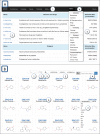ZINC 15--Ligand Discovery for Everyone
- PMID: 26479676
- PMCID: PMC4658288
- DOI: 10.1021/acs.jcim.5b00559
ZINC 15--Ligand Discovery for Everyone
Abstract
Many questions about the biological activity and availability of small molecules remain inaccessible to investigators who could most benefit from their answers. To narrow the gap between chemoinformatics and biology, we have developed a suite of ligand annotation, purchasability, target, and biology association tools, incorporated into ZINC and meant for investigators who are not computer specialists. The new version contains over 120 million purchasable "drug-like" compounds--effectively all organic molecules that are for sale--a quarter of which are available for immediate delivery. ZINC connects purchasable compounds to high-value ones such as metabolites, drugs, natural products, and annotated compounds from the literature. Compounds may be accessed by the genes for which they are annotated as well as the major and minor target classes to which those genes belong. It offers new analysis tools that are easy for nonspecialists yet with few limitations for experts. ZINC retains its original 3D roots--all molecules are available in biologically relevant, ready-to-dock formats. ZINC is freely available at http://zinc15.docking.org.
Figures





References
Publication types
MeSH terms
Substances
Grants and funding
LinkOut - more resources
Full Text Sources
Other Literature Sources
Miscellaneous

